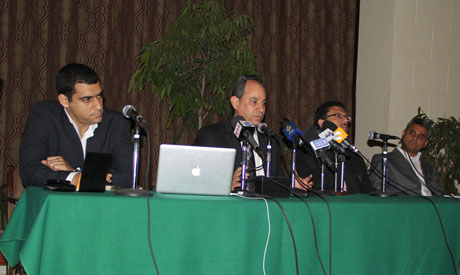
Dr. Ehab Abdel Rahman, head of the AUC research team, pictured with the thermoacoustic engine (Photo: AUC Egypt)
A team of researchers at the American University in Cairo (AUC) announced at a Tuesday press conference that they had successfully developed an eco-friendly device that could turn heat into sound – and, later, into electricity – that they say could help Egypt meet its energy needs.
The thermoacoustic engine was developed by a team of AUC faculty members and graduate students from diverse universities. The team was led by Ehab Abdel-Rahman, associate dean of graduate studies and research at the School of Sciences and Engineering and director of the Youssef Jameel Science and Technology Research Centre.
The project has cost some $3 million since the AUC team began working on it in 2006, according to Abdel-Rahman, with funding from King Abdullah of Science and Technology, and the Swedish International Development Cooperation Agency (SIDA), among others.
The engine, which can convert heat (solar-generated and otherwise) into sound, and subsequently into electric power, produces no harmful emissions and is one of the least costly methods of producing clean, renewable energy, said Abdel-Rahman.
"The engine uses simple materials that have no special requirements, are commercially available in large quantities, and are relatively cheap," he explained.
"This would represent a national solution to Egypt's energy problem," the scientist added. "It is imperative to move toward renewable energy sources to help meet growing energy needs and counter global environmental challenges."

Dr. Ehab Abdel Rahman and members of the AUC research team
In the two years since Egypt's 2011 revolution, the country has been plagued by increasingly frequent power cuts due to fuel shortages. This happens especially during the summer season, which in recent years has coincided with the Islamic fasting month of Ramadan, during which electricity consumption usually rises.
The team, to whom AUC has extended funding until June of this year, is currently seeking fresh funds for the construction of a larger version of the engine, capable of generating four to five kilowatts of electricity – enough to power a modern household.
In the future, said Abdel-Rahman, an even larger engine could produce up to 30 kilowatts of power.
The energy produced could be channelled into a power grid or used in generators – which traditionally rely on fossil fuels – to counter power outages, or in off-grid areas such as construction sites.
The first-ever thermoacoustic device was built in 1983. Yet today, "there are less than one hundred researchers worldwide working in the field of thermoacoustics," said Abdel-Rahman, most of them in China, Japan, Germany, the US, and the Netherlands.
Abdel-Rahman began working on the project 15 years ago at the University of Utah in the United States.
The prototype developed by Abdel-Rahman and the AUC team converts input heat at an efficiency rate of almost 30 percent, the highest possible rate for thermal engines.
Short link: